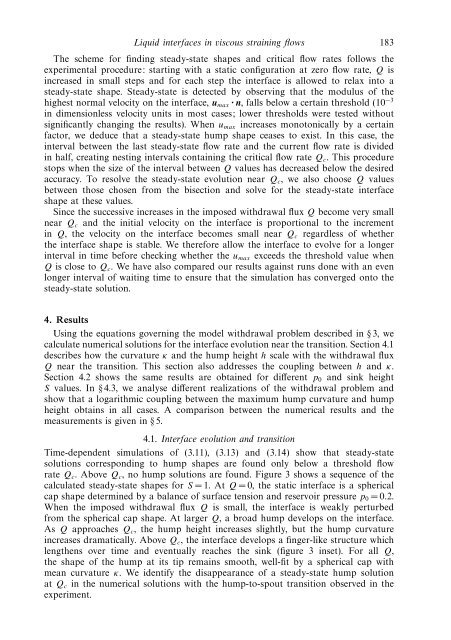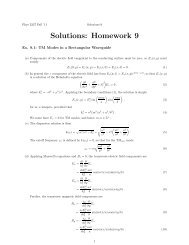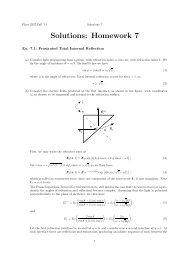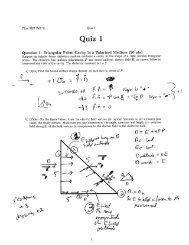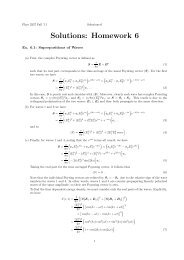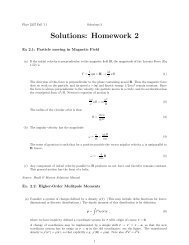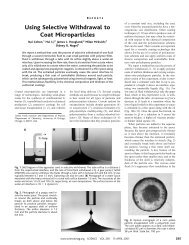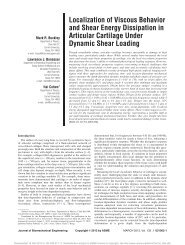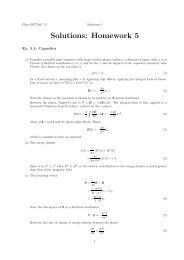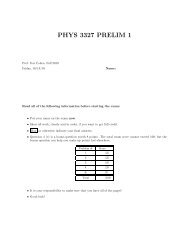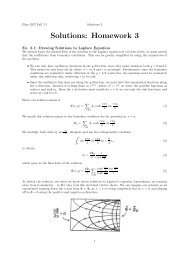Liquid interfaces in viscous straining flows ... - Itai Cohen Group
Liquid interfaces in viscous straining flows ... - Itai Cohen Group
Liquid interfaces in viscous straining flows ... - Itai Cohen Group
Create successful ePaper yourself
Turn your PDF publications into a flip-book with our unique Google optimized e-Paper software.
<strong>Liquid</strong> <strong><strong>in</strong>terfaces</strong> <strong>in</strong> <strong>viscous</strong> stra<strong>in</strong><strong>in</strong>g <strong>flows</strong> 183The scheme for f<strong>in</strong>d<strong>in</strong>g steady-state shapes and critical flow rates follows theexperimental procedure: start<strong>in</strong>g with a static configuration at zero flow rate, Q is<strong>in</strong>creased <strong>in</strong> small steps and for each step the <strong>in</strong>terface is allowed to relax <strong>in</strong>to asteady-state shape. Steady-state is detected by observ<strong>in</strong>g that the modulus of thehighest normal velocity on the <strong>in</strong>terface, u max · n, falls below a certa<strong>in</strong> threshold (10 −3<strong>in</strong> dimensionless velocity units <strong>in</strong> most cases; lower thresholds were tested withoutsignificantly chang<strong>in</strong>g the results). When u max <strong>in</strong>creases monotonically by a certa<strong>in</strong>factor, we deduce that a steady-state hump shape ceases to exist. In this case, the<strong>in</strong>terval between the last steady-state flow rate and the current flow rate is divided<strong>in</strong> half, creat<strong>in</strong>g nest<strong>in</strong>g <strong>in</strong>tervals conta<strong>in</strong><strong>in</strong>g the critical flow rate Q c . This procedurestops when the size of the <strong>in</strong>terval between Q values has decreased below the desiredaccuracy. To resolve the steady-state evolution near Q c ,wealsochooseQ valuesbetween those chosen from the bisection and solve for the steady-state <strong><strong>in</strong>terfaces</strong>hape at these values.S<strong>in</strong>ce the successive <strong>in</strong>creases <strong>in</strong> the imposed withdrawal flux Q become very smallnear Q c and the <strong>in</strong>itial velocity on the <strong>in</strong>terface is proportional to the <strong>in</strong>crement<strong>in</strong> Q, the velocity on the <strong>in</strong>terface becomes small near Q c regardless of whetherthe <strong>in</strong>terface shape is stable. We therefore allow the <strong>in</strong>terface to evolve for a longer<strong>in</strong>terval <strong>in</strong> time before check<strong>in</strong>g whether the u max exceeds the threshold value whenQ is close to Q c . We have also compared our results aga<strong>in</strong>st runs done with an evenlonger <strong>in</strong>terval of wait<strong>in</strong>g time to ensure that the simulation has converged onto thesteady-state solution.4. ResultsUs<strong>in</strong>g the equations govern<strong>in</strong>g the model withdrawal problem described <strong>in</strong> § 3, wecalculate numerical solutions for the <strong>in</strong>terface evolution near the transition. Section 4.1describes how the curvature κ and the hump height h scale with the withdrawal fluxQ near the transition. This section also addresses the coupl<strong>in</strong>g between h and κ.Section 4.2 shows the same results are obta<strong>in</strong>ed for different p 0 and s<strong>in</strong>k heightS values. In § 4.3, we analyse different realizations of the withdrawal problem andshow that a logarithmic coupl<strong>in</strong>g between the maximum hump curvature and humpheight obta<strong>in</strong>s <strong>in</strong> all cases. A comparison between the numerical results and themeasurements is given <strong>in</strong> § 5.4.1. Interface evolution and transitionTime-dependent simulations of (3.11), (3.13) and (3.14) show that steady-statesolutions correspond<strong>in</strong>g to hump shapes are found only below a threshold flowrate Q c .AboveQ c , no hump solutions are found. Figure 3 shows a sequence of thecalculated steady-state shapes for S =1. At Q = 0, the static <strong>in</strong>terface is a sphericalcap shape determ<strong>in</strong>ed by a balance of surface tension and reservoir pressure p 0 =0.2.When the imposed withdrawal flux Q is small, the <strong>in</strong>terface is weakly perturbedfrom the spherical cap shape. At larger Q, a broad hump develops on the <strong>in</strong>terface.As Q approaches Q c , the hump height <strong>in</strong>creases slightly, but the hump curvature<strong>in</strong>creases dramatically. Above Q c , the <strong>in</strong>terface develops a f<strong>in</strong>ger-like structure whichlengthens over time and eventually reaches the s<strong>in</strong>k (figure 3 <strong>in</strong>set). For all Q,the shape of the hump at its tip rema<strong>in</strong>s smooth, well-fit by a spherical cap withmean curvature κ. We identify the disappearance of a steady-state hump solutionat Q c <strong>in</strong> the numerical solutions with the hump-to-spout transition observed <strong>in</strong> theexperiment.


